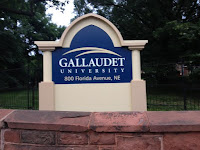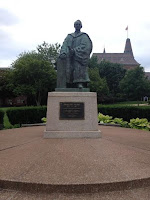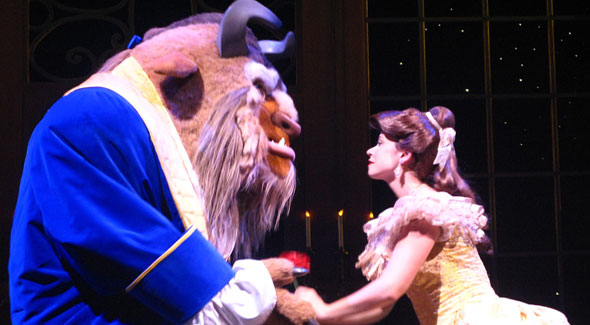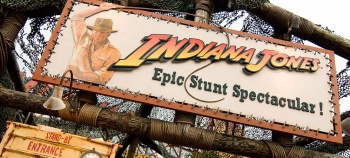 A poster was put up in Benson Halls, where we are staying on Gallaudet University advertising a film created by Michelle Banks, entitled 'Reflections: Of a Black, Deaf Woman'. We thought 'why the hell not?' and decided to go along because it might be interesting to see the minority within a minority viewpoint. I was not expecting a one woman show that was for sure, Michelle Banks taking centre stage with her on stage god mother/ interpreter coming on stage for scene intervals and narrating the whole thing. God knows how. 'Reflections' was a pure and beautiful example of all that sign language can offer, showing the vivacious production of emotions and role shift from one character to another. I watched Michelle Banks turn from a lecherous old miser into a spritely young child, with the help of a few costume changes. I have never seen such good acting. It would be an insult to even compare the signing to English. No English structure was used, it was a show of sign language in its most unadulterated form, mixed with Michelle Bank's unbelievable acting skills, the two merging together to create a fluid, dynamic piece, smooth as silk and eye wateringly visual.
A poster was put up in Benson Halls, where we are staying on Gallaudet University advertising a film created by Michelle Banks, entitled 'Reflections: Of a Black, Deaf Woman'. We thought 'why the hell not?' and decided to go along because it might be interesting to see the minority within a minority viewpoint. I was not expecting a one woman show that was for sure, Michelle Banks taking centre stage with her on stage god mother/ interpreter coming on stage for scene intervals and narrating the whole thing. God knows how. 'Reflections' was a pure and beautiful example of all that sign language can offer, showing the vivacious production of emotions and role shift from one character to another. I watched Michelle Banks turn from a lecherous old miser into a spritely young child, with the help of a few costume changes. I have never seen such good acting. It would be an insult to even compare the signing to English. No English structure was used, it was a show of sign language in its most unadulterated form, mixed with Michelle Bank's unbelievable acting skills, the two merging together to create a fluid, dynamic piece, smooth as silk and eye wateringly visual.
It made me wish that I had immersed myself in American Sign Language sooner, cocooning myself in visual pieces of artwork, training my eyes to the alien movements found in this different language so I could piece together more parts for myself, understanding the beauty of the pictures created and acting, rather than rely on the lacking voice over or captions. Watching a BSL piece similar to this, I would grasp the majority of what was said but I felt like an outsider looking in as the deaf audience around me giggled at something that the captions hadn't quite moved onto yet, leaving a few second delay. Giuseppe Giuranna, the VV specialist who I briefly met at DeaFest this year, once told the mixed audience that hearing people could only understand eighty per cent of signed visual performances, whereas the deaf could appreciate it fully. This is something I would like to test to see if correct, but for 'Reflections' I wish I had full access. I knew something beautiful and powerful was happening but did not fully grasp the language enough to understand what that thing was.
Michelle Bank's performance could have made up a series of stage shows and her pieces ranging from the hilarious to the viscerally heart breaking. She spills her imagined creation onto stage through dance, sign and acting, showing the audience a imagined life where the character suffers discrimination both through her race and through her deafness. The character's deafness was little talked about in the show, only referred to when she expressed attraction to hearing men or how she didn't find friends in a mainstream school. This changed when moved to a school for the deaf, a common theme with children fluent in sign language who use sign at home.
The second production seen at Gallaudet was no less brilliant but in a different way. 'Miser' was a triumph and the only show I have seen where sign language is incorporated into the script itself. The interpreters sat dressed in black, set back from the stage as if seated in the walls of the house, under the captioning board. Some of the funniest parts were when the actors themselves, like in Disney, interacted with the interpreters. At one point, one of the more physical actresses creeping over the stage right interpreter whilst the interpreter sat stone faced as if she didn't have a pantalooned and masked actress sliding over her legs. She carried on as if nothing had happened as the audience howled. Other actors also came stumbling across them, the character of Harpagon falling over them and yelling 'WHO ARE YOU?' incredulously and then mumbling that the thieves were taking over the house as the interpreters nonchalantly signed his words. Pure comedic gold.
 When two of the characters wanted to speak privately, they signed to each other, whilst their father went of on a spoken soliloquy on the other side of the stage. The characters slipped into sign seamlessly when the deaf character came on stage, interestingly the Miser himself did not understand sign and when he was interacting with the character of Mariane, another cast member interpreted as if in real life. Whole scenes were conducted in sign, with the captions expressing what was being signed, the actors and actresses obviously practicing their lines in sign and some seeming more natural than others. Through careful polishing it worked incredibly well, the deaf character seeming like a normal fixture in theatre as should be.
When two of the characters wanted to speak privately, they signed to each other, whilst their father went of on a spoken soliloquy on the other side of the stage. The characters slipped into sign seamlessly when the deaf character came on stage, interestingly the Miser himself did not understand sign and when he was interacting with the character of Mariane, another cast member interpreted as if in real life. Whole scenes were conducted in sign, with the captions expressing what was being signed, the actors and actresses obviously practicing their lines in sign and some seeming more natural than others. Through careful polishing it worked incredibly well, the deaf character seeming like a normal fixture in theatre as should be.  For the most part, I did not watch the interpreters, too distraction by the endless motion on stage and the loud dialogue and action, choosing to use my ears to access the action. The genre of Commedia dell'Arte is possibly the most visual genre of theatre, the characters forever moving and shouting, a over animated, over accentuated portrayal of movement with impressive acrobatic acts throughout the dialogue. YouTube it, I can't describe it. This made for very hard interpreting, with sometimes a long delay between the speech and the sign translation. The ending was a hilarious mess of colour and noise and movement and I believe it was one of the best and most accessible piece of theatre I will ever see. An added bonus was the one and only Roberta Cordano, the first Female Deaf President of Gallaudet University sat in the row in front of me, an arms width away. Cue: controlled fangirling.
For the most part, I did not watch the interpreters, too distraction by the endless motion on stage and the loud dialogue and action, choosing to use my ears to access the action. The genre of Commedia dell'Arte is possibly the most visual genre of theatre, the characters forever moving and shouting, a over animated, over accentuated portrayal of movement with impressive acrobatic acts throughout the dialogue. YouTube it, I can't describe it. This made for very hard interpreting, with sometimes a long delay between the speech and the sign translation. The ending was a hilarious mess of colour and noise and movement and I believe it was one of the best and most accessible piece of theatre I will ever see. An added bonus was the one and only Roberta Cordano, the first Female Deaf President of Gallaudet University sat in the row in front of me, an arms width away. Cue: controlled fangirling. 



















